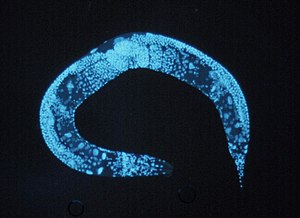Model organism/Catalogs
Jump to navigation
Jump to search



Important model organisms
Viruses
Viruses include:
- Phage Lambda
- Phi X 174 - its genome was the first ever to be sequenced. The genome is a circle of 11 genes, 5386 base pairs in length.
- Tobacco mosaic virus
Prokaryotes

Sporulating Bacillus subtilis
Prokaryotes include:
- Escherichia coli (E. coli) - This common gut bacterium is the most widely-used organism in molecular genetics.
- Bacillus subtilis
- Caulobacter crescentus - a bacterium that divides into two distinct cells used to study cellular differentiation.
- Mycoplasma genitalium - a minimal organism
- Vibrio fischeri - quorum sensing, bioluminescence and animal-bacterial symbiosis with Hawaiian Bobtail Squid
- Synechocystis, a photosynthetic cyanobacteria widely used in photosynthesis research.
- Pseudomonas fluorescens, a soil bacterium that readily diversifies into different strains in the lab.
Eukaryotes
Eukaryotes include:
Protists
- Chlamydomonas reinhardtii - a unicellular green alga used to study photosynthesis, flagella and motility, regulation of metabolism, cell-cell recognition and adhesion, response to nutrient deprivation and many other topics. Chlamydomonas reinhardtii has a well-studied genetics, with many known and mapped mutants and expressed sequence tags, and there are advanced methods for genetic transformation and selection of genes.[1] Sequencing of the Chlamydomonas reinhardtii genome was reported in October 2007.[2] A Chlamydomonas genetic stock center exists at Duke University, and an international Chlamydomonas research interest group meets on a regular basis to discuss research results. Chlamydomonas is easy to grow on an inexpensive defined medium.
- Dictyostelium discoideum is used in molecular biology and genetics (its genome has been sequenced), and is studied as an example of cell communication, differentiation, and programmed cell death.
- Tetrahymena thermophila - a free living freshwater ciliate protozoan.
- Emiliania huxleyi - a unicellular marine coccolithophore alga, extensively studied as a model phytoplankton species.
Fungi
File:Budding yeast tomography.jpg
Budding yeast tomography
- Aspergillus nidulans, subject of genetics studies
- Neurospora crassa - orange bread mold (genetic studies of meiosis, metabolic regulation, and circadian rhythm)[3]
- Ashbya gossypii, cotton pathogen, subject of genetics studies (polarity, cell cycle)
- Saccharomyces cerevisiae, baker's yeast or budding yeast (used in brewing and baking)
- Schizosaccharomyces pombe, fission yeast, subject of genetic studies
Plants
- Arabidopsis thaliana, currently the most popular model plant. This herbaceous dicot is a crucifer, a member of the mustard family. Its small stature and short generation time facilitates genetic studies, [4] and many phenotypic and biochemical mutants have been mapped.[4] Arabidopsis was the first plant to have its genome sequenced.[4] Its genome sequence, along with a wide range of information concerning Arabidopsis, is maintained by the TAIR database.[4]
(Plant physiology, Developmental biology, Molecular genetics, Population genetics, Cytology, Molecular biology) - Selaginella moellendorffii is a remnant of an ancient lineage of vascular plants and key to understanding the evolution of land plants. It has the smallest genome size of any plant reported (~110Mb) and its sequence will be released by the Joint Genome Institute in early 2008. (Evolutionary biology, Molecular biology)
- Brachypodium distachyon is an emerging experimental model grass that has many attributes that make it an excellent model for temperate cereals. (Agronomy, Molecular biology, Genetics)
- Lotus japonicus a model legume used to study the symbiosis responsible for nitrogen fixation. (Agronomy, Molecular biology)
- Lemna gibba is a rapidly-growing aquatic monocot, one of the smallest flowering plants. Lemna growth assays are used to evaluate the toxicity of chemicals to plants in ecotoxicology. Because it can be grown in pure culture, microbial action can be excluded. Lemna is being used as a recombinant expression system for economical production of complex biopharmaceuticals. It is also used in education to demonstrate population growth curves.
- Arabidopsis thaliana, currently the most popular model plant. This herbaceous dicot is a crucifer, a member of the mustard family. Its small stature and short generation time facilitates genetic studies, [4] and many phenotypic and biochemical mutants have been mapped.[4] Arabidopsis was the first plant to have its genome sequenced.[4] Its genome sequence, along with a wide range of information concerning Arabidopsis, is maintained by the TAIR database.[4]
- Maize (Zea mays L.) is a cereal grain. It is a diploid monocot with 10 large chromosome pairs, easily studied with the microscope. Its genetic features, including many known and mapped phenotypic mutants and a large number of progeny per cross (typically 100-200) facilitated the discovery of transposons ("jumping genes"). Many DNA markers have been mapped and the genome is being sequenced. (Genetics, Molecular biology, Agronomy)
- Medicago truncatula is a model legume, closely related to the common alfalfa. Its rather small genome is currently being sequenced. It is used to study the symbiosis responsible for nitrogen fixation. (Agronomy, Molecular biology)
- Tobacco BY-2 cells is suspension cell line from tobacco (Nicotiana tabaccum). Useful for general plant physiology studies on cell level. Genome of this particular cultivar will be not sequenced (at least in near future), but sequencing of its wild species Nicotiana tabaccum is presently in progress. (Cytology, Plant physiology, Biotechnology)
- Rice (Oryza sativa) is used as a model for cereal biology. It has one of the smallest genomes of any cereal species, and sequencing of its genome is finished. (Agronomy, Molecular biology)
- Physcomitrella patens is a moss increasingly used for studies on development and molecular evolution of plants.[5] It is so far the only non-vascular plant (and so the only "primitive" plant) with its genome completely sequenced.[5] (Plant physiology, Evolutionary biology, Molecular genetics, Molecular biology)
- Populus is a genus used as a model in forest genetics and woody plant studies. It has a small genome size, grows very rapidly, and is easily transformed. The genome sequence of Poplar (Populus trichocarpa) sequence is publicly available.
- See also Chlamydomonas reinhardtii, above under Protists.
Animals
Invertebrates
- Arbacia punctulata, the purple-spined sea urchin, classical subject of embryological studies
- Aplysia, a sea slug, whose ink release response serves as a model in neurobiology and whose growth cones serve as a model of cytoskeletal rearrangements.
- Caenorhabditis elegans, a nematode, usually called C. elegans[6] - an excellent model for understanding the genetic control of development and physiology. C. elegans was the first multicellular organism whose genome was completely sequenced
- Ciona intestinalis, a sea squirt
- Drosophila, usually the species Drosophila melanogaster - a kind of fruit fly, famous as the subject of genetics experiments by Thomas Hunt Morgan and others. Easily raised in lab, rapid generations, mutations easily induced, many observable mutations. Recently, Drosophila has been used for neuropharmacological research[7]. (Molecular genetics, Population genetics, Developmental biology).
- Euprymna scolopes, the Hawaiian bobtail squid, model for animal-bacterial symbiosis, bioluminescent vibrios
- Hydra (genus), a Cnidarian, is the model organism to understand the evolution of bilaterian body plans
- Loligo pealei, a squid, subject of studies of nerve function because of its giant axon (nearly 1 mm diameter, roughly a thousand times larger than typical mammalian axons)
- Pristionchus pacificus, a roundworm used in evolutionary developmental biology in comparative analyses with C. elegans
- Stomatogastric ganglion of various arthropod species; a model for motor pattern generation seen in all repetitive motions
- Strongylocentrotus purpuratus, the purple sea urchin, widely used in developmental biology
- Symsagittifera roscoffensis, a flatworm, subject of studies of bilaterian body plan development
- Tribolium castaneum, the flour beetle - a small, easily kept darkling beetle used especially in behavioural ecology experiments
Vertebrates

Laboratory mice
- Cavia porcellus, the guinea pig, used by Robert Koch and other early bacteriologists as a host for bacterial infections, hence a byword for "laboratory animal" even though less commonly used today
- Chicken (Gallus gallus domesticus) - used for developmental studies, as it is an amniote and excellent for micromanipulation (e.g. tissue grafting) and over-expression of gene products
- Cat (Felis cattus) - used in neurophysiological research
- Dog (Canis lupus familiaris) - an important respiratory and cardiovascular model
- Hamster - first used to study kala-azar (leishmaniasis)
- Mouse (Mus musculus) - the classic model vertebrate. Many inbred strains exist, as well as lines selected for particular traits, often of medical interest, e.g. body size, obesity, muscularity. (Quantitative genetics, Molecular evolution, Genomics)
- Homo sapiens (humans) - used in various clinical studies
- Lamprey - spinal cord research
- Oryzias latipes, Medaka (the Japanese ricefish) is an important model in developmental biology, and has the advantage of being much sturdier than the traditional Zebrafish
- Rat (Rattus norvegicus) - particularly useful as a toxicology model; also particularly useful as a neurological model and source of primary cell cultures, owing to the larger size of organs and suborganellar structures relative to the mouse. (Molecular evolution, Genomics)
- Rhesus macaque - used for studies on infectious disease and cognition
- Sigmodon hispidus - Cotton rat formerly used in polio research
- Taeniopygia guttata or zebra finch - used in the study of the song system of songbirds and the study of non-mammalian auditory systems
- Takifugu rubripres, a pufferfish - has a small genome with little junk DNA
- Xenopus laevis, the African clawed frog - used in developmental biology because of its large embryos and high tolerance for physical and pharmacological manipulation
- Zebrafish (Danio rerio), a freshwater fish, has a nearly transparent body during early development, which provides unique visual access to the animal's internal anatomy. Zebrafish are used to study development, toxicology and toxicopathology,[8] specific gene function and roles of signaling pathways.
Model organisms used for specific research objectives
Sexual selection and sexual conflict
- Callosobruchus maculatus, the bruchid beetle
- Chorthippus parallelus, the meadow grasshopper
- Coelopidae - seaweed flies
- Diopsidae - stalk-eyed flies
- Drosophila spp. - fruit flies
- Gryllus bimaculatus, the field cricket
- Scathophaga stercoraria, the yellow dung fly
Hybrid zones
Ecological genomics
- Daphnia pulex, an environmental indicator model organism
- ↑ Chlamydomonas reinhardtii resources at the Joint Genome Institute
- ↑ Chlamydomonas genome sequenced published in Science, October 12, 2007
- ↑ Rowland H. Davis: Neurospora. Contributions of a Model Organism. Oxford University Press, Oxford, 2000. ISBN 0-19-512236-4.
- ↑ Jump up to: 4.0 4.1 4.2 4.3 About Arabidopsis on The Arabidopsis Information Resource page (TAIR)
- ↑ Jump up to: 5.0 5.1 Rensing, S. A., Lang, D., Zimmer, A. D., Terry, A., Salamov, A., Shapiro, H. et al. (2008). The physcomitrella genome reveals evolutionary insights into the conquest of land by plants. Science, 319(5859), 64-69.
- ↑ Riddle, Donald L.; Blumenthal, Thomas; Meyer, Barbara J.; and Priess, James R. (Eds.). (1997). C. ELEGANS II. Woodbury, NY: Cold Spring Harbor Press. ISBN 0-87969-532-3. Full text available on-line.
- ↑ Manev H, Dimitrijevic N, Dzitoyeva S. (2003). "Techniques: fruit flies as models for neuropharmacological research.". Trends Pharmacol. Sci. 24 (1): 41–43. DOI:10.1016/S0165-6147(02)00004-4. Research Blogging.
- ↑ Spitsbergen J.M. and Kent M.L. (2003). The state of the art of the zebrafish model for toxicology and toxicologic pathology research—advantages and current limitations. Toxicol Pathol. 31 (Supplement), 62-87. PubMed Abstract Link => PMID 12597434.


